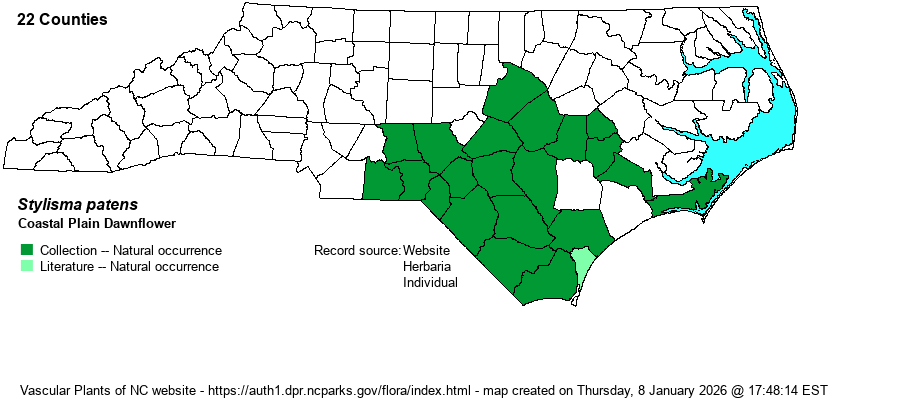| Author | (Desrousseaux) Myint | |
| Distribution | Present throughout the southern half of the Coastal Plain, including the Sandhills region. Ranges barely into the southeastern Piedmont. Occurs north to Wake and Greene counties.
This is a Southern species found north only to eastern NC, and south to northern FL and west to MS.
| |
| Abundance | Fairly common to common in the Sandhills and in other areas southeast to Pender and Brunswick counties. Uncommon in the northern portion of the range. It is the most numerous of the five species of Stylisma in the state. | |
| Habitat | This is another Stylisma of sandy soil, typically in pine/scrub oak sandhills, as are S. angustifolia and S. humistrata. Of course, it also grows on sandy roadsides and other sandy clearings. | |
| Phenology | Blooms from June to August, and fruits shortly after flowering. | |
| Identification | This is a slender herbaceous vine, trailing on the ground to about 3-4 feet long. It has alternate and somewhat slender leaves, somewhat oblong to lanceolate, about 1-1.5 inches long but about 1/4-inch wide. From the axils grow 1-3 small flowers, on stalks around 1-inch long, each white flower being funnel-shaped but barely 4/5-inch long and across. There are several similar species, also prostrate like this. S. patens has leaves mostly about 4-6 times as long as wide, as opposed to about 7-15 times as long as wide in S. angustifolia, which has linear leaves. Also, S. patens has quite hairy sepals, whereas those of S. angustifolia are glabrous. The quite rare S. pickeringii has even narrower leaves, about 2 inches long but barely 1/10-inch wide, essentially needle-like, and usually stiffy erect; its flowers are also quite erect and have villous sepals. S. humistrata also grows in sandy places like these others but its leaves are about 1/2-inch wide and the flowers grow 3-7 (on average) in a cluster instead of mainly just singly. Biologists who work in the sandy parts of the southern Coastal Plain are probably familiar with all four of these and can identify each without much problem, even by the leaves. However, for many other people, you may have to collect or measure a leaf or look at the sepals or other characters to be sure. As mentioned in Abundance, this may well be the first Stylisma you encounter, particularly in the Sandhills region. | |
| Taxonomic Comments | Some botanists have moved S. angustifolia out from this species. Others still retain the latter as a subspecies or variety, however. All Stylisma species were formerly named as Bonamia species.
| |
| Other Common Name(s) | Common Dawnflower, Sandhill Dawnflower, Sandhill Morning-glory | |
| State Rank | S4 | |
| Global Rank | G5T3T5 [G3G5] | |
| State Status | | |
| US Status | | |
| USACE-agcp | | |
| USACE-emp | | |

